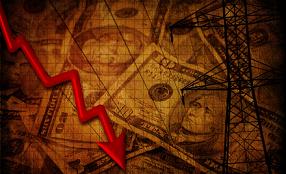The US Economy is Stuck in Misery

The middle class is dead. The US has produced a self-sustaining two-class society. Most Lower Class Americans are in bad or uncertain economic shape but the rich and powerful Upper Class crowd keeps making and spending money as if there has been no recession.
Talk about a possible double-dip recession misses the larger reality: For many millions of Americans the first recession is still here; there has been no recovery for them. Too bad President Obama cannot comprehend that. Nice that only 23 percent of people believe that his policies have made economic conditions better. Maybe they got the change they were waiting for.
A new survey by the Pew Research Center provides disturbing data that no amount of lies from politicians can refute. Without a lot more consumer spending, remember, the US economy will not regain lasting health. The scope of the economic shock is shown by the 60 percent of Americans that have cut down on borrowing and spending. And nearly 50 percent are in worse financial shape because of the economic downturn. Forty percent of adults have tapped savings and retirement accounts to make ends meet. Nearly 25 percent have had to borrow money from someone. Ten percent have moved back with their parents to survive the economic tsunami, and that rises to 24 percent for workers between 18 and 29 years old.
More and more Americans now recognize that retirement will have to wait. For those 62 and older and still working, 35 percent have postponed retirement. That jumps to 60 percent as a likely action for working adults between ages 50 and 61. Replace the golden years with the disappointment years, especially when inevitable reduced Social Security and Medicare benefits hit hard.
For those still lucky enough to have jobs, the Commerce Department reports that the personal savings rate in May — the part of wage income that goes unspent — rose to 4 percent, the highest amount in nearly a year, as anxious consumers faced continued economic woes, such as fears about losing jobs or homes, affording food and health care, and a tumbling stock market.
And always remember that the official jobless rate of just under 10 percent is pure bunk; it really is close to 20 percent nationally, and a lot worse in many places and for African-Americans and Hispanics. The average time for being without a job is now six months, with many more people jobless for a whole lot more, often several years. All this means suppressed consumer spending and continued high home foreclosure rates. No big surprise that consumer confidence crashed almost 10 points between May and June. Welcome to high anxiety.
Also keep in mind that even as the general consumer spending shows little life, the Upper Class keeps on living it up. Gallup reported “Upper-income Americans’ self-reported spending rose 33% to an average of $145 per day in May — up from $109 per day in April 2010 and May 2009, and the highest monthly average since November 2008.” The rest of the population’s self-reported spending averaged $59 per day in May. So, rich Americans are spending nearly twice as much as the vast majority of Americans every day. Indeed, Tiffany reports sales up 17 percent in the jeweler’s most recent quarter. Overall US luxury sales, says MasterCard SpendingPulse, jumped 22.7 percent in March, over the previous year. The increase in luxury buying appears to be coming almost totally from the “ultra-affluents,” those households making over $250,000 a year. Their first-quarter spending increased 22.6 percent, meaning that they have returned to spending at pre-recession levels.
And here is a gem of a new statistic. In 2009, the Economic Policy Institute reports that the typical working American with a four-year college degree took home $1,025 per week, $5 a week less than Americans with a four-year degree took home, after adjusting for inflation, in the year 2000. How’s that for progress?
Meanwhile, almost half of U.S. companies that reduced or suspended their contributions to employee retirement plans during the recession haven’t restored them.
The ultra ugly truth is that there is very little hope for the US economy providing true prosperity for the vast majority of people in the foreseeable future. Unemployment will remain high and consumer spending will remain low except for the wealthy. Economic inequality is terrible and punishing most Americans who should forget about that fabled American dream. To visualize America ‘s staggeringly unequal distribution of wealth, suggests University of Tennessee at Martin historian David Barber, envision a 100-seat auditorium filled with 100 people. If seating in that auditorium reflected our current wealth distribution, the single richest person in the hall “would be able to spread out smartly” over nearly 43 seats. The poorest 60 would have to squeeze into just one.
As government deficits continue at historic high levels there will be even more pain as local and state governments cut employment and services. All the economic impacts of the BP oil spill in the Gulf region will continue to expand and reverberate and it is doubtful that enough money will come from BP to those in pain soon enough to prevent catastrophes for millions of people.
Some impacted people may turn to religion as if God has not already shown total disdain for humanity. Some will delude themselves that voting for certain candidates in the coming midterm elections will help. Others will bury themselves in various distractions or choose to believe the political lies of President Obama and other politicians. [How did all that federal stimulus spending work for you?] Perhaps far more Lower Class people [Are you in denial about your Lower Class status?] should consider the advice of the deeply cynical: Kill Yourself. If only politicians would take that advice.
Happy Fourth of July. Time to try and remember the good old days.
Contact Joel S. Hirschhorn at delusionaldemocracy.com.

